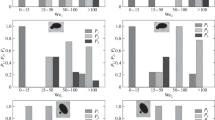Abstract
In the investigation of the process of the breakdown of emulsions by the coalescence of drops, up to the present time, use has been made of the theory of the coagulation of colloids (for example, [1]). However, there is a considerable difference between colloids and emulsions. Forces of attraction, bringing about the coalescence of two colloidal particles, become predominant at distances much greater than the particle size, so that, in a hydrodynamic sense, it can be assumed that colloidal particles do not interact. On the contrary, the disperse phase in emulsions consists of molecularly smooth spherical drops with a size from a few tenths of a micron or more and, with approach of the drops, forces of hydrodynamic interaction, inhibiting coalescence, become substantial. As a rule, the drops can be regarded as rigid undeformed spheres since their surface is stabilized by surface-active substances. With the approach of such spheres, the layer of liquid between them generates a braking force proportional to the rate of approach of the drops and inversely proportional to the distance between their surfaces. As a result, the approach of drops under the action of a finite force takes place over an infinite time. It follows from this that the process of the coalescence of drops requires the presence of a force of attraction, rising to infinity with approach of the drops, and any theory of coalescence must take simultaneous account of the forces of attraction of the drops and of the hydrodynamic forces.
Similar content being viewed by others
Literature cited
V. G. Levich, Physicochemical Hydrodynamics [in Russian], Izd. Fizmatgiz, Moscow (1959).
A. J. Goldman, R. G. Cox, and H. Brenner, “Slow viscous motion of a sphere parallel to a plane wall, Part 2. Couette flow,” Chem. Engng. Sci.,22, 653 (1967).
M. E. O'Neill, “A sphere in contact with a plane wall in a slow linear shear field,” Chem. Engng. Sci.,23, 1293 (1970).
C. J. Lin, K. J. Lee, and N. R. Sather, “Slow motion of two spheres in a shear field,” J. Fluid. Mech.,43, 35 (1970).
S. L. Goren, “The normal force exerted by creeping flow on a small sphere touching a plane,” J. Fluid. Mech.,41, 619 (1970).
G. B. Jeffrey, “On the steady rotation of a solid of revolution in a viscous fluid,” Proc. London Math. Soc., (Ser. 2),14, 327 (1915).
M. Stimson and G. B. Jeffrey, “The motion of two spheres in a viscous fluid,” Proc. Roy. Soc.,111, A, 110 (1926).
J. Happel and H. Brenner, Low Reynolds Number Hydrodynamics, Prentice-Hall, Englewood Cliffs, N. J. (1965).
M. E. O'Neill and S. R. Majumdar, “Asymmetrical slow viscous fluid motions caused by the translation or rotation of two spheres, Part 1. The determination of exact solutions for any values of the ratio of radii and separation parameters, Part 2. Asymptotic forms of the solutions when the minimum clearance between the spheres approaches zero,” ZAMP,21, 164 (1970).
M. D. A. Cooley and M. E. O'Neill, “On the slow motion generated in a viscous fluid by the approach of a sphere to a plane wall or stationary sphere,” Mathematika,16, 37 (1969).
A. D. Maude, “End effects in a falling-sphere viscosimeter,” J. Appl. Phys.,12, 293 (1961).
M. E. O'Neill, “A slow motion of a viscous liquid caused by the rotation of a solid sphere,” Mathematika,11, 67 (1964).
W. R. Dean and M. E. O'Neill, “A slow motion of a viscous liquid caused by the rotation of a solid sphere,” Mathematika,10, 13 (1963).
A. J. Goldman, R. G. Cox, and H. Brenner, “Slow viscous motion of a sphere parallel to a plane wall, Part 1. Motion through a quiescent liquid,” Chem. Engng. Sci.,22, 637 (1967).
M. H. Davis, “Two charged spherical conductors in a uniform electric field: forces and field strength,” Quart. J. Mech. Appl. Math.,17, 499 (1964).
Author information
Authors and Affiliations
Additional information
Translated from Izvestiya Akademii Nauk SSSR, Mekhanika Zhidkosti i Gaza, No. 5, pp. 61–68, September–October, 1973.
Rights and permissions
About this article
Cite this article
Entov, V.M., Kaminskii, V.A. & Sinaiskii, É.G. Capture of small drops by large drops in an electric field. Fluid Dyn 8, 729–735 (1973). https://doi.org/10.1007/BF01023571
Received:
Issue Date:
DOI: https://doi.org/10.1007/BF01023571




